From the mid-spring in the gardens of Russia blooms beautiful lush shrubs of the Chubuschik. They are abundantly covered with white buds, exacerbating a magnificent sweet-fresh flavor. Description of this plant, characteristics of popular varieties, planting and care and care features you will find in this article.
General description of culture
The Chubuschnik belongs to the Hydrangee family, and its genus has at least 70 different varieties. The Russian name of the Chubushnik happened from the word "Chubuk", which was denoted a certain part of the tube for smoking. The fact is that such detail was made precisely from the wood of the plant described. By the way, the Chubuschnik found an application in the manufacture and other crafts, for example, musical instruments: flutes and twin. Solid, strong trunks and branches are not suitable for creating such items.
Very often, the Chubudnik is mistakenly called Jasmine, although these plants belong to completely different families and differ outwardly. The only similarity, because of which the Chubushnik is confused with a low room jasmine is a fragrant fragrance of plant flowers.
In addition to its beauty, abundant flowering and indescribable smell, culture can please the owners also unpretentious in care. Growing at the same place over 10 years old, the canchousenik requires minimal care. The plant perfectly tolerates long-term frosts and does not lose the ability to flowering, even being in a small shadow. All activities that are required to maintain the vital activity of the shrub are in rare feeders by the Organic, as well as in periodic watering into arid weather.
Chubuschnik: Popular varieties
As mentioned earlier, the generation of this culture includes about 70 different types of shrubs, but we would like to call the most popular varieties, describing their main characteristics:
- The Chubuschnik "Variagrata" is popular among the gardeners, because it looks very impressive. The decorativeness of this culture is due not only to the presence of large snow-white inflorescences, but also a magnificent type of foliage, which is painted in 2 contrasting shade. Green in the middle, a leaf of this Chubuschnik around the edges has a light, almost white kaym. The bush of the plant grows up to 2.5 m and looks quite lush and spread, reaching in diameter almost the same size as height. Chubuschnik "Variagrata" blooms in the late spring, covered with snow-white fragrant buds. The flowering period lasts about 20-25 days. After the petals will shift from his buds, small boxes with seeds are formed in their place. This kind of plant is perfectly tolerate the shadens, but will bloom better if you plan it on a well-lit plot. Culture loves wet and nutritious soil, but before her landing do not forget to make a good drainage, because there is no stagnation of water so the chubushnik does not endure. In the cold summer, the variety of "Variagates" is not very abundant, but it reacts perfectly to organic and mineral fertilizers, racing in Krone and giving more buds. Young plants in the first winter after their landing is preferably insulated. Putting the Chubuschnik "Variagat" at the end of September or spring, before the beginning of the growing season. This average grade due to its pomp is well suited for the formation of a living hedge in the garden.
- Chubudnik "Virginal" also applies to average grades and reaches a height from 1.5 to 2.5 m. Flowers culture from May to June, it is especially abundantly covered by buds in the event that it grows on a well-lit territory and sufficiently wet soil. Careful care Shrub does not require, it takes only from time to time to water, following the soil did not stop. It is also desirable to periodically loosen the upper layer of the Earth with rakes, to give roots to air access and prevent extensive moisture in the soil. In terms of soil, Virginal variety is completely unpretentious, moreover, this species is resistant to diseases and tolerate long-term cold and frost. Like the previous variety, such a canbushnik is often used in creating live elevations, borders and various flower arrangements.
- The terry chubushnik variety "Snowstorm" during his flowering looks just great. It is in abundance covered with brushes of white magnificent buds, as a result of which it becomes like a tree noticed by snow. The diameter of the inflorescences of this variety is large and can reach an indicator of 8-9 cm. The shrub grows in a height of up to 3 m, and it blooms mainly in July, pleased with its magnificence for at least a month. Like many other varieties, the "snowstorm" has a brightly pronounced floral flavor with notes of freshness. The plus of this species can be considered that it perfectly transfers freezing and long-term cold. However, young bushes in the first winter it is advisable to stream, so that they do not penetrate. Chubuschnik "Snowstorm" blooms well in sunny places, loves wet, but not swampy soil, and also requires periodic trimming, which helps maintain its decorativeness at a high level. The main pest of this variety is the TLA, the appearance of which can be prevented by timely handling of shrubs with suitable insecticides. The "snowstorm" looks well in the living hedges, as well as in single landings.
- The Chubuschnik of the Spray Variety "Aureus" has excellent decorative properties not only due to beautiful fragrant flowers, but also appearance of foliage. Young leaves scrubby on a shrub in the spring, painted in a gentle greenish-yellow shade. During the summer, foliage gradually changes its color to light green, and the leaves fall fall away and not soily. The buds of such ancient chubushnik are rather small and not too distinguished against the background of the shrub itself, but the inflorescences exuded a strong and very pleasant smell that creates a fragrant aura around the bush. This average grade reaches a height of about 2.5 m, the flowering of it falls at the very end of the spring and lasts about 3 weeks. So that the Chubuschnik had a magnificent crown and abundantly bloomed, it should be trimmed at no less than 1 time in 3 years. The plant speaks well on top dressing by manure. Most often, this culture is used in complex landings, with its help form hedges and borders. You can also plant such a canbushnik in compositions with other plants, thanks to its bright foliage, it will become a central focus of the plant ensemble.
- The Pearchug's Chubuschik is also very popular among the gardeners, the reason for this is the beautiful magnificent buds reaching 7 cm in diameter. This type of chubusnik has terry flowers, a snow-white shade of which favorably contrasts with a one-photon grain of foliage. This variety refers to low-spirited cultures and grows no more than 1.3 m in height. The flowering period of the Chubuschik comes on the second half of June and lasts about 2-3 weeks. The plant is frost resistant, easily survives during frosts up to -25 ° C, but blooms abundantly if you plan it in the sunny area. The soil prefers fertile, well-fertilized soil. Low bushes growth allows you to use such a canbushnik not only in flower borders, but also on the flower beds along with other colors.
- The Chubuschnik "Air landing" flowers with small buton-bells, the diameter of which does not exceed 3 cm. Flowers in such a plant are not only white, but also light beige. Sometimes this variety is also called "strawberry" because its delicate white inflorescences exudes the fragrance, very similar to the smell of strawberries. The average shrub of such a canbushnik grows up to 2 m in height, blooms culture in June or in July, depending on the climatic conditions of the band, where it grows. During the flowering period, the plant produces a fairly large amount of inflorescences that are happy with the eye long enough - about a month. Unlike other varieties of the Chubushnik, giving abundant flowering under bright sunlights, the "air landing" grade is beautiful even in conditions of constant shaders. Like many other species, such a chubbynik is frost-resistant, besides, it is not subject to many common floral diseases. A plant in flower arrangements and single landings are used.
- The Gordon's Chubuschnik can be attributed to tall cultures, because his bush reaches 4-6 m in height. This variety blooms in the second half of June, covering brushes from snow-white inflorescences. The duration of flowering is approximately 3 weeks. The diameter of one flower is 4-4.5 cm, there are about 7-9 such flowers in inflorescences. Glossy foliage painted into a monophonic dark green shade. This variety of culture needs periodic trimming. In connection with the tallestness, the Gordon's Cubusnik is not used in complex landings and hedges, but shrubs can be planted one by one, making them a central decoration of the garden.
- Drubunnik Lemuca refers to hybrid varieties, he was derived by crossing an ordinary Chubuschnik with mellite. Such a shrub grows in a height of about 3 m, and also has a large spreader crown, the diameter of which sometimes reaches at least 3.5 m. Large, with a diameter of 5.5 cm buds, painted in white and collected in inflorescences. The canchousenik of this variety has a pronounced sweet aroma. The foliage in the plant is monophonic, dark green. With the arrival of autumn leaves, the color changes, becoming bright yellow. Flowers culture in July, but in good conditions can give re-blossom in early autumn. The flowering period is long, about 25 days. The hybrid chubushnik Lemian is very resistant to cold and frost, easily transfers the shadens. In one place, such a bush can grow at least 20 years, but needs regular trimming. In landscape design, it is used as part of flower ensembles, grown in green hedges, perfectly harmonizes with other varieties of the Chubudnik.
- The Chubudnik variety "Komsomolets" a few decades ago was considered the most popular species of this culture. Its snow-white buds are quite large, in diameter reach 5 cm. They are collected in inflorescences of 7-9 flowers in each. The plant has a strong, but very pleasant and gentle smell with sweet-fresh notes. The foliage in such an octolar cannist, painted in dark green, has a slightly elongated shape. The culture bush is small, it grows no more than 2 m. The Komsomolets blooms in July and pleases with its beauty at least 25 days. This variety moves well freezing and cold, adult plants do not need to be stolen even when the air temperature drops to -30 ° C. Such a plant does not like drought, therefore needs regular irrigation.
- The Chubudnik variety "Gnome" is a low-spirited plant, which is understandable from his name. The height of the bushes of such a culture does not exceed 0.5 m. At the same time, bushes are pretty stretched and reached in diameter 70 cm. Interesting, this kind of chubushnik is also interesting because it does not bloom, and the decorative qualities of the plant are caused by the appearance of the bush itself. Like many other varieties, "Gnome" rather winter articles. In addition, it is not whitewashed to the composition of the soil and grows well on most types of soil. In care, the plant is undemandingly, and in landscape design, it is most often used to create low borders. Such bushes can be drawn by the borders of the flower beds, and you can use the potatone as part of the flower arrangement. This variety has a good haircut, thanks to which you can give the bushes a variety of forms.
- Chubuschnik variety "Alebaster" flowers with snow-white chip-type buds. The flowers in this culture are very large, their diameter reaches 13 cm. Buds are collected in the brush of 7-10 pieces each. The mid-grade bushes of the Chubushnik "Alebaster" grow no more than 1.8 m in height. This culture begins to bloom in the second half of June and is distinguished by a very long flowering period, which lasts 38 days. The main care is in timely irrigation, as well as in the annual trimming.
Features of the reproduction of the Chubudnik
The landing of the pot can be carried out in two ways: stalling or disembarking seeds. The simplest and most popular way is the shilling. Young shoots cut off the bush mainly in the summer months, choosing those branches that managed to partially wore. Delete cuttings from a maternal plant is best in a period of flowering or before it starts. So that the shoots released the roots, they need to be transferred to the unheated greenhouse or an open bed, prepared in advance by last fall. The so-called "heel" should be present on the transplant cutlery, which is a kind of protrusion on wood. It is also desirable that on the branch there was at least one bud, ready to open soon. Plant cutlets should be in the soil consisting of peat, rubble and sand. So far before planting, it is necessary to moisten well, as well as to pour a fungicide.
The transplantable escape needs to be released from the lower leaves, and then immerse in the soil so that it is inclined relative to the Earth by 35-40 °. The remaining leaves should not touch the soil. After that, the sprout is covered with a glass can or transparent polyethylene package. In the reproduction of the Chubuschnik, it is important to provide the plant daily moisturizing, which consists in abundant irrigation of the shoot of the spray gun.
Sometimes the Chubuschnik breeds and seeds, but this type of cultivation is acceptable only for species plants. With seed reproduction, varietal signs of culture may be lost, so the hybrids are not similarly bred at all. In addition, the plant grown from seed blooms only 5 years after landing.
For those who are interested in this method of breeding, some of its features should be known:
- Seed seeds can be seed in spring, autumn, as well as in the winter months. In this case, stratify the seeds of culture is not necessary.
- Planting seeds in winter is carried out directly into the snowmalls. In the autumn and spring grain deepen into the ground, in advance prepared pits.
- The depth of planting seeds of the Chubusnik is 30 cm. After immersing the grains into the soil, the earth needs to be covered with branches, spruce vegetable or dry hay. In this form, landing is left until spring. As soon as the garden melts the snow, branches or grass can be removed.
- In the spring of the seeds of the Chubudnik, it is customary to sow in the greenhouse. For 1 m² of area, approximately 1 g of sowing material is planted.
- Seed germination can be accelerated by soaking them in the epin solution. Material is first folded into the tissue bag, and then immersed in the named solution for no time. Then the seeds are transferred to peat for 2 days.
Planting the Chubuschik in Open Ground and Plant Care
So that the plant has taken root in a new place and pleased with abundant bloom from year to year, one should listen to some recommendations for the cultivation of this culture:
- Most of the varieties of the Chubusnik bear a light shadension, but the most magnificent bloom is given only if they grow on a well-lit place. Choosing the territory for the flower beds, give preference to those sites where many sunlight falls. In the shaded places, the Chubuschnik will also bloom, but this process can start much later, and the buds themselves will be small and unpleasant. At the growing in the shadow of the Chubuschnik, the appearance of foliage is also worse, it becomes smaller, thinner and loses brightness.
- Some varieties of culture are quite unpretentious to the soil, but most of the varieties still love fertile and nutritious soils. The soil for the pot can be wet, but also stagnation of water in the ground This plant does not like very much.
- In the hot summer months, mainly in June and in July, culture must be regularly water. The amount of water is determined at the rate of 20 liters per bush.
- Caring for the canobusnik involves both periodic fertilizers in the soil. For season 1, the plant must be picked up at least twice. For these purposes, organic fertilizers are used: a borologist and manure. The feeders are carried out until mid-August. Among other things, annually the soil around the potochnik is recommended to saturate minerals. Here you can use superphosphate, urea or potassium sulfur. When the bushes are flashing, there should be a small amount of wood ash.
- With a group landing of the pots, you need to observe the distance of 0.7-0.8 m between the individual bushes. If the culture has a very empty crown, it is better to increase this distance to 1.5 m.
- Transplanted cuttings, like young bushes of the plant, it is better to warm up for the winter. For such a goal, straw, hay, husk fitting. In the snowy winter you can simply cover the landing of a big breast snow.
- The Chubuschnik is quite resistant to plant diseases and pests, but sometimes he may be amazed or a spider tick. If there is a similar problem, the bushes, like the Earth around them, you need to process insecticides.
Pruning Chubuschnik
The Chubuschnik grows quickly enough and to keep it in a tidy form, it is necessary to periodically cut the culture. Some varieties of the plant cut up to 2 times a year. If you do not spend timely pruning, the shrub begins to bloom worse, the inflorescences themselves are minced and losing a decorative look.
The main branches of the Chubushnik are cut into 1-2 strong kidneys, but weak shoots are removed completely, and they do it at any time of the year. When the growing season occurs, a large number of new shoots appear on the plant located at the main branches. At the bottom of the crown also appears several new strong processes. When trimming, all weak branches are completely removed, and strongly shortening so that they harmoniously fit into the shape of the bush. If the shrub is too high, it can also be shortened at the top.
A year later, the old branches are swinging, they are cut together with new weak shoots. In about October, a new increase grows up to 1 m in length and will acquire in small branches, which the next season will produce inflorescences.
Too thickened and empty crowns should be reversed, removing ¼ of all old branches.
Chubuschnik, photo:

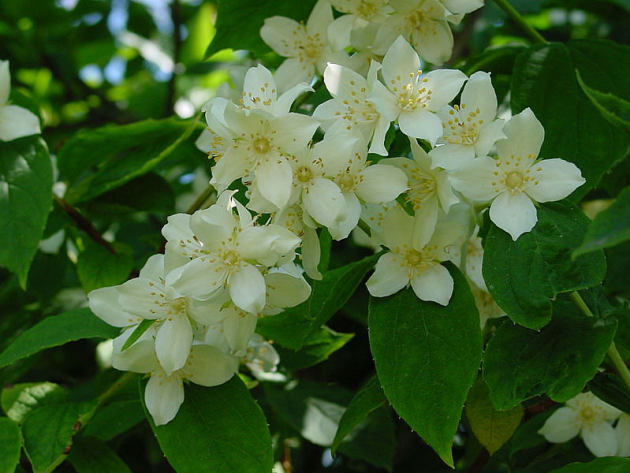
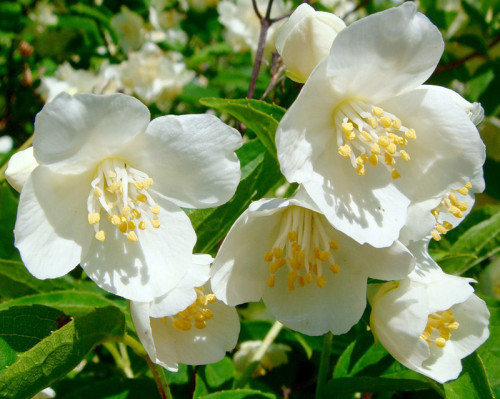
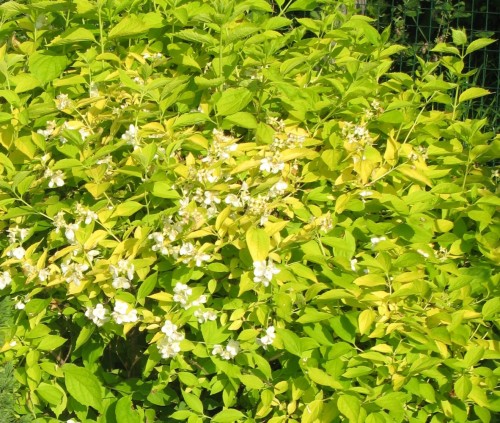
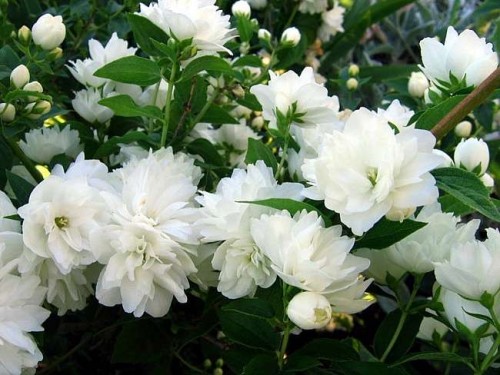
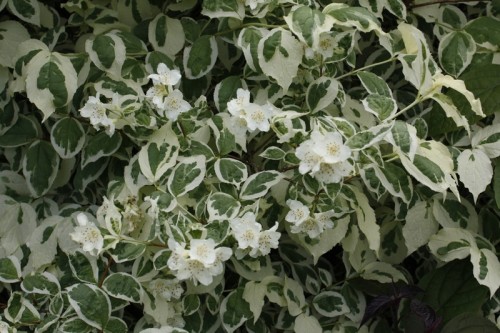
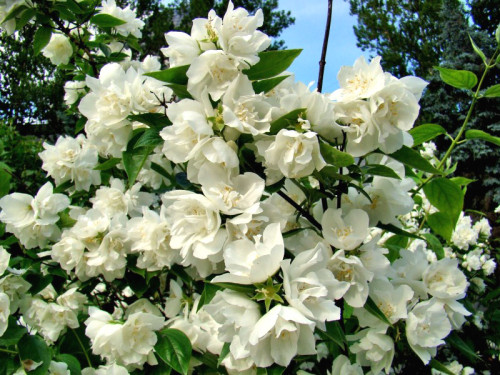

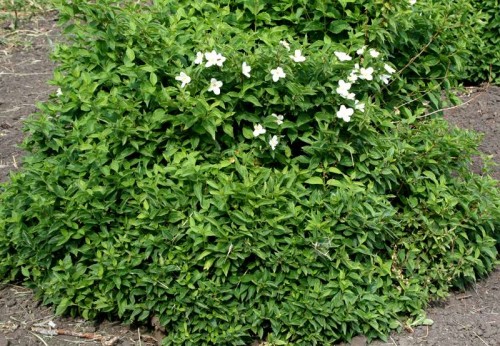
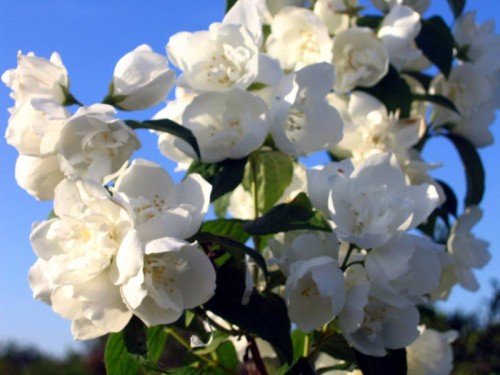

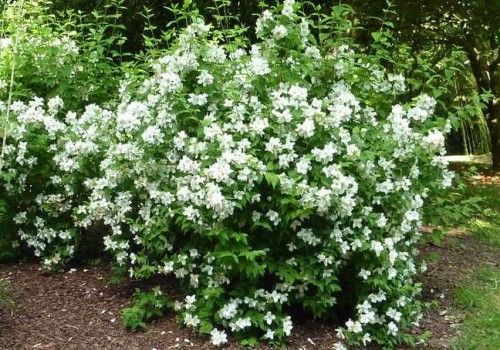
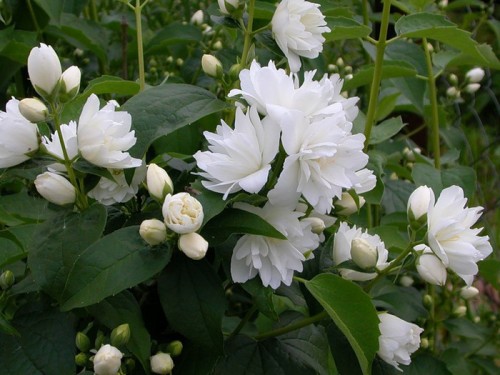












 Start a discussion ...
Start a discussion ...